 Although William Shakespeare probably sets the record in what concerns the amount of mystery surrounding a writer’s life, Jonathan Swift may very likely be a close second. The work of his biographers should certainly be a painful one, for the simple reason that they have to work with very inadequate amounts of information. Mystery surrounds not only his writing (some of his works are so strange that it is virtually impossible to establish any objective truths as to what they, in fact, mean), but his life as well.
Although William Shakespeare probably sets the record in what concerns the amount of mystery surrounding a writer’s life, Jonathan Swift may very likely be a close second. The work of his biographers should certainly be a painful one, for the simple reason that they have to work with very inadequate amounts of information. Mystery surrounds not only his writing (some of his works are so strange that it is virtually impossible to establish any objective truths as to what they, in fact, mean), but his life as well.
There are almost no facts about his life that we would be completely sure of. What exactly were his relationships with women he nicknames “Stella” and “Vanessa”, was he married to either of them, was he really kidnapped by his wet-nurse when he was a child, was his mother’s husband, who died before his birth, really his father – nobody can answer these questions for sure. Anyways, there was an attempt to address these and many other questions in a new work dedicated to Jonathan Swift by Leo Damrosch, “Jonathan Swift: His Life and His World”.
Previously the most complete piece of research on the writer was considered to be a gigantic three-volume work “Swift: The Man, His Works and the Age” by Irvin Ehrenpreis. And it may be said that one of the main reasons why Damrosch has written his book was to disagree with Ehrenpreis and some other scholars who worked on Swift in the past, giving different interpretations of some events and aspects of his life and paying special attention to Freudian viewpoint used by Ehrenpeis in his book, which Damrosch considers to be groundless and offensive.
Leo Damrosch approaches the study of Swift from a different direction – he pays much more attention to two elements of his personality that pervade the majority of his works: “a probing, ironic, skeptical intelligence” and his commitment to the past, which he saw in an idealized manner. They appear first in “The Battle of the Books”, the first book written by Swift, and more or less consistently continue to show up in all his subsequent works. In general, it seems that Swift was full of similar contradictions: he was an Anglican who despised Henry VIII, the founder of his church, he was a Tory who considered the majority of Tories to be unworthy of the positions they kept and so on.
But whatever new approach Damrosch utilizes in his book, we should understand one thing: it just yet another interpretation. We weren’t able to understand Swift for three hundred years, and it is unlikely that we will manage to do it now.